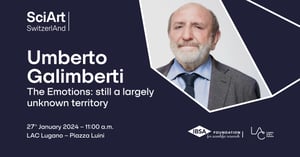On 27 January 2024, at 11 am, an audience was held at LAC (the Lugano Arte e Cultura cultural centre) with renowned philosopher and psychoanalyst Umberto Galimberti, as part of the IBSA Foundation's SciArt SwitzerlAnd project, in partnership with LAC.
The event focused on the theme of emotions; Umberto Galimberti, philosopher and psychoanalyst, described how they are central elements in today's society, yet remain veiled in mystery.
The mind and the heart.
Throughout the history of humanity, before the enlightenment of the rational mind, individuals’ decisions were guided by the heart. This primordial mechanism enabled our ancestors to respond rapidly to danger, based on immediate emotions such as fear and desire. In the modern age, dominated by the rationality of technology, the emotions are often repressed or commoditised.
How can we recognise and value real emotions? Galimberti guided the audience on this explorative journey, seeking to shed light on the most hidden corners of our emotional experience.
The event is not just a reflection on the emotions but is also part of the IBSA Foundation SciArt SwitzerlAnd project, which aims to emphasise the crossover areas between science and art. Against this backdrop, Galimberti's analysis of the emotions can provide valuable insights into how science – and specifically psychology – and art can interact and influence each other.










Umberto Galimberti

Italian philosopher and psychoanalyst. In his studies he has pursued a complex path with a strong emphasis on Jungian teaching. His area of interest focuses on the man who, in a world dominated by technology, feels like a cog in a universe of wheels, unable to give meaning to his existence.
A student of Emanuele Severino, he became a Professor of Cultural Anthropology (1976), then Professor of the Philosophy of History at the University of Venice (1983), where he also taught dynamic psychology; he has been a member of the International Association of Analytical Psychology since 1985. Through a critical examination of the limits of psychoanalysis in the face of the "senselessness" that characterises the age of technology, Galimberti reaches the conclusion that perhaps only a "philosophical approach" can help achieve a critical understanding of the technological world in which we find ourselves and guide us to find meaning in our profound unease, in the tragic nature of our existence, including by reclaiming the Greek ideal of wisdom yet without resorting to religious mythologies.
His works include: Heidegger, Jaspers e il tramonto dell'Occidente (Heidegger, Jaspers and the Decline of the West, 1975), Psichiatria e fenomenologia (Psychiatry and Phenomenology, 1979), Il corpo (The Body, 1983), La terra senza il male. Jung dall'inconscio al simbolo (The Earth without Evil. Jung from the Unconscious to the Symbol, 1984), Gli equivoci dell'anima (Misunderstandings of the Soul 1987), Psiche e techne. L'uomo nell'età della tecnica (Psyches and Techniques. Man in the Age of Technology, 1999), Orme del sacro (Traces of the Sacred, 2000), Il tramonto dell'Occidente (The Decline of the West, 2005), La casa di psiche. Dalla psicoanalisi alla pratica filosofica (The House of Psyches. From Psychoanalysis to Practical Philosophy, 2005), Parole nomadi (Nomadic Words, 2006), L'ospite inquietante. Il nichilismo e i giovani (The Disturbing Guest. Nihilism and the Young, 2007), Il segreto della domanda. Intorno alle cose umane e divine (The Secret of the Question. Around Human and Divine Things, 2008), La morte dell'agire e il primato del fare nell'età della tecnica (The Death of Action and the Supremacy of Doing in the Age of Technology, 2009), I miti del nostro tempo (The Myths of our Time, 2009), Il viandante della filosofia (The Wayfarer of Philosophy, with M. Alloni, 2011), Cristianesimo. La religione del cielo vuoto (Christianity. The Religion of the Empty Sky, 2012) and L'usura della Terra (The Usuary of the Earth, 2014). In 2018, La parola ai giovani (The Word to the Young) and Nuovo dizionario di psicologia (The New Dictionary of Psychology); Heidegger e il nuovo inizio (Heidegger and the New Beginning, 2020); in 2021, Il libro delle emozioni (The Book of the Emotions) and, with C. Vivarelli, 50 emozioni spiegate ai ragazzi (50 Emotions Explained to the Young); Credere (To Believe, with J. Carrón, 2022); Le parole di Gesù (The Words of Jesus, 2023). Galimberti is also the author of a lengthy Dizionario di psicologia (Dictionary of Psychology, 1992), with many reissues, and of the Nuovo dizionario di psicologia (New Dictionary of Psychology). Psichiatria, psicoanalisi, neuroscienze (Psychiatry, Psychoanalysis, Neurosciences, 2018).
About SciArt SwitzerlAnd
To create a stimulating conversation between spheres that are simultaneously both distant and linked in an effort to promote scientific culture as part of a journey of international research into Science and the Arts:
This is the goal with which SciArt SwitzerlAnd was founded, a project by IBSA Foundation for scientific research, in partnership with the LAC cultural centre (Lugano Arte e Cultura) and Lugano's MASI museum (Museo d’arte della Svizzera italiana).
Science and the arts have always coexisted through time and space. Albeit with different methods and for different purposes, artists and scientists both observe the world around them and open up new perspectives, interpretations and meanings for us to explore.
Using different event formats and digital products, SciArt SwitzerlAnd plans to place its focus on those artistic creations that have been transformed thanks to their interactions with scientists, with new discoveries and with research institutions.
The public will be offered a look at fascinating projects, the products of different dimensions intersecting, and be able to listen to the voices of artists and scientists explaining the extent to which spheres that are so different can mutually influence one another.
The new project is perfectly aligned with the mission of the Foundation, which has been committed since 2012 to disseminating scientific culture that is trustworthy, sharing principles and knowledge using language that is accessible, and raising awareness of topics relating to science and culture as well as to personal health and well-being.


